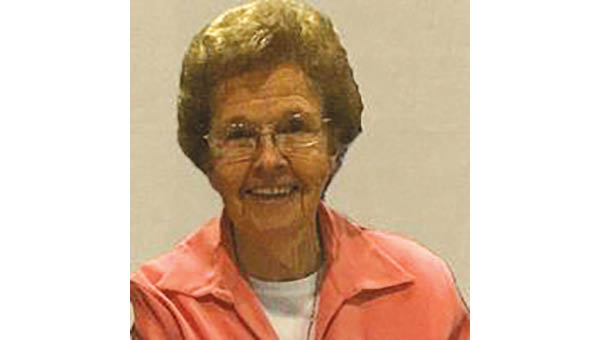Butler pastor marks record as oldest to swim ‘Ice Mile’
Published 3:04 pm Thursday, January 25, 2024
|
Getting your Trinity Audio player ready...
|
By Buzz Trexler
Star Correspondent
BUTLER – While most of northeast Tennessee was looking forward to an abatement of freezing temperatures earlier this week, Donald Winters, pastor at Sugar Grove Baptist Church, needed the winter weather to hang around at least one more day.
The reason: the waters of Watauga Lake needed to be at least 41 degrees or below so he could set a Guinness World Record as the oldest person to swim an “Ice Mile.”
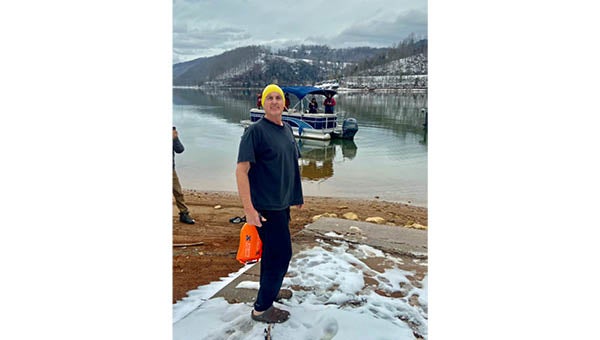
Photo Courtesy of Donald Winters “Ice Mile” Team
Donald Winters, pastor at Sugar Grove Baptist Church, in Butler, poses for a photo Tuesday, Jan. 23, 2024, at Watauga Lake before beginning his swim to break the “Ice Mile” record.
According to the Guinness World Records website, until Winters did so the official record holder was Ger Purcell, who completed the Ice Mile at the age of 66 years, 12 days, on Jan. 30, 2021, in Limerick, Ireland. Winters turned 66 on Oct. 10, which makes his age 66 years, 105 days.
Trending
When Winters entered the icy waters of Watauga Lake at 12:43 p.m. Tuesday, exiting it at 1:36 p.m., it was the culmination of a journey that began sometime around 2015.
“When I moved up here to the church, Scott Vandiver, a good friend of mine, he’s a physician, had a triathlon that they ran out of our church parking lot and we helped him with it, and part of it was the swim end,” Winters said. “About eight or nine years ago they got me into swimming again.”
Winters said he had grown up swimming, but his interest in the sport grew.
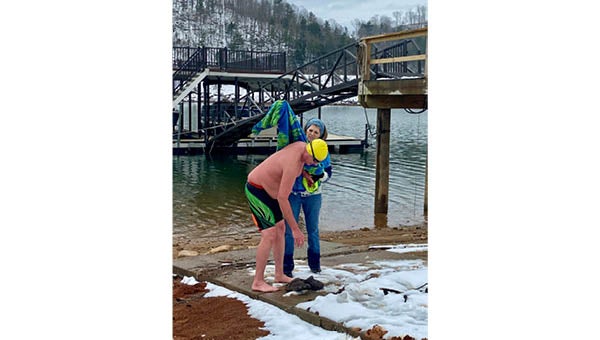
Photo Courtesy of Donald Winters “Ice Mile” Team Lena Winters drapes her husband, Donald Winters, with a towel Tuesday, Jan. 23, 2024, after his swim in Watauga Lake to break the “Ice Mile” record.
“Then I got to wondering whether a person could swim year around because you see people over in Europe and up north doing polar plunges and stuff, so I kinda got interested in cold-water immersion,” Winters said. It was four years ago that he first began swimming in cold water while wearing a wetsuit. “Then in February I just took the wetsuit off,” he said, gradually increasing the time – five, 10, 15 minutes, and on.
It’s called “Ice Swimming.”
According to its website, the International Ice Swimming Association (IISA) was formed in 2009 seeking to make it an “extreme sport with a clear set of safety and integrity rules.” The criteria: swimming in water temperature of 41 degrees or lower, unassisted, wearing a standard swimming suit, goggles, and a single silicon cap.
Trending
Winters had read about the Ice Mile, which is exactly what it says: swimming one mile in icy waters under IISA regulations, which are extensive and specific – both in preparation and during the event.
It got Winters to thinking: “Well, maybe I ought to try that since I’ve been swimming all year long anyway.”
“I had worked up to where I had about enough time in the cold to where I could do it, but then the water temperatures got too high,” he said.
This past fall, Winters started swimming on Mondays, Wednesdays, and Fridays, and continued it into the winter months.
“About a month back, I Googled the oldest man to ever do an Ice Mile and found out he was younger than I was,” he said. “I thought, ‘Well, I’ve gone this far with it, I might as well give it a try and see how it goes.”
Giving it “a try” goes far beyond just getting in the water and swimming: Winters had to do a qualifying swim and submit videos to IISA. He also had to undergo a physical and an EKG, and then form his IISA-required team.
“Yeah, it took us a while to get all of our ducks in a row,” he said.

Photo Courtesy of Donald Winters “Ice Mile” Team Donald Winters, pastor at Sugar Grove Baptist Church, in Butler, wades toward the shore Tuesday, Jan. 23, 2024, at Watauga Lake after his swim to break the “Ice Mile” record as his boat team watches.
On Tuesday afternoon, Winters and a team required by the IISA rules – an IISA-qualified observer, water safety personnel, medical officer, and videographer, just to name a few — gathered at Art Barber’s boat dock, near the church. Winters said there were about 25 people on hand to see him, including his team members: Carolyn Curtis, IISA official observer; Steve Owens, IISA official observer and medical doctor; his wife, Lena Winters, who served as his “second” (the person who assists the swimmer); Bill Stover, boat driver and an observer; and his daughter, Sarah Esquivel, Lance Thieme, and Katharine Adams served as photographers.
Three digital thermometers recorded the water temperature the half-hour before the swim: 39.4, 38.1, and 38.8 degrees.
Winters was videoed as he got dressed, entered the water, swam one-tenth of a mile past the half-mile mark, and returned.
The rest is recorded history that will be sent to IISA to mark the record.
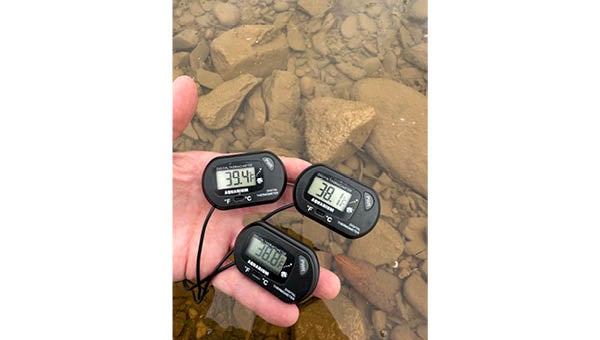
Photo Courtesy of Donald Winters “Ice Mile” Team Three digital thermometers record the temperature of Watauga Lake on Tuesday, Jan. 23, 2024, as Donald Winters, pastor at Sugar Grove Baptist Church in Butler, begins his swim to break the “Ice Mile” record.
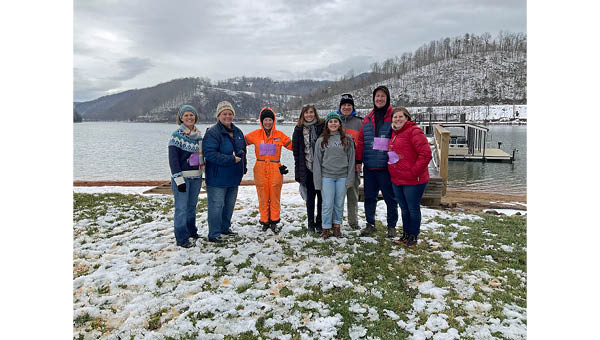
Photo Courtesy of Donald Winters “Ice Mile” Team Donald Winters, pastor at Sugar Grove Baptist Church in Butler, was required by International Ice Swimming Association regulations to form a support team for his “Ice Mile” record attempt. Shown at Watauga Lake on Tuesday, Jan. 23, 2024, are (from left) Lena Winters, Ginny Lapin (church member and friend), Katharine Adams, Carolyn Curtis, Abigail Esquivel (granddaughter- toboggan in the front), Bill Stover (back), Lance Thieme, and Sarah Esquivel.

Photo Courtesy of Donald Winters “Ice Mile” Team Donald Winters, pastor at Sugar Grove Baptist Church in Butler, swims in the icy waters of Watauga Lake on Tuesday, Jan. 23, 2024, to break an “Ice Mile” record for the oldest person to do so.

Photo Courtesy of Donald Winters “Ice Mile” Team Donald Winters, pastor at Sugar Grove Baptist Church in Butler, swims in the icy waters of Watauga Lake on Tuesday, Jan. 23, 2024, to break an “Ice Mile” record for the oldest person to do so.





